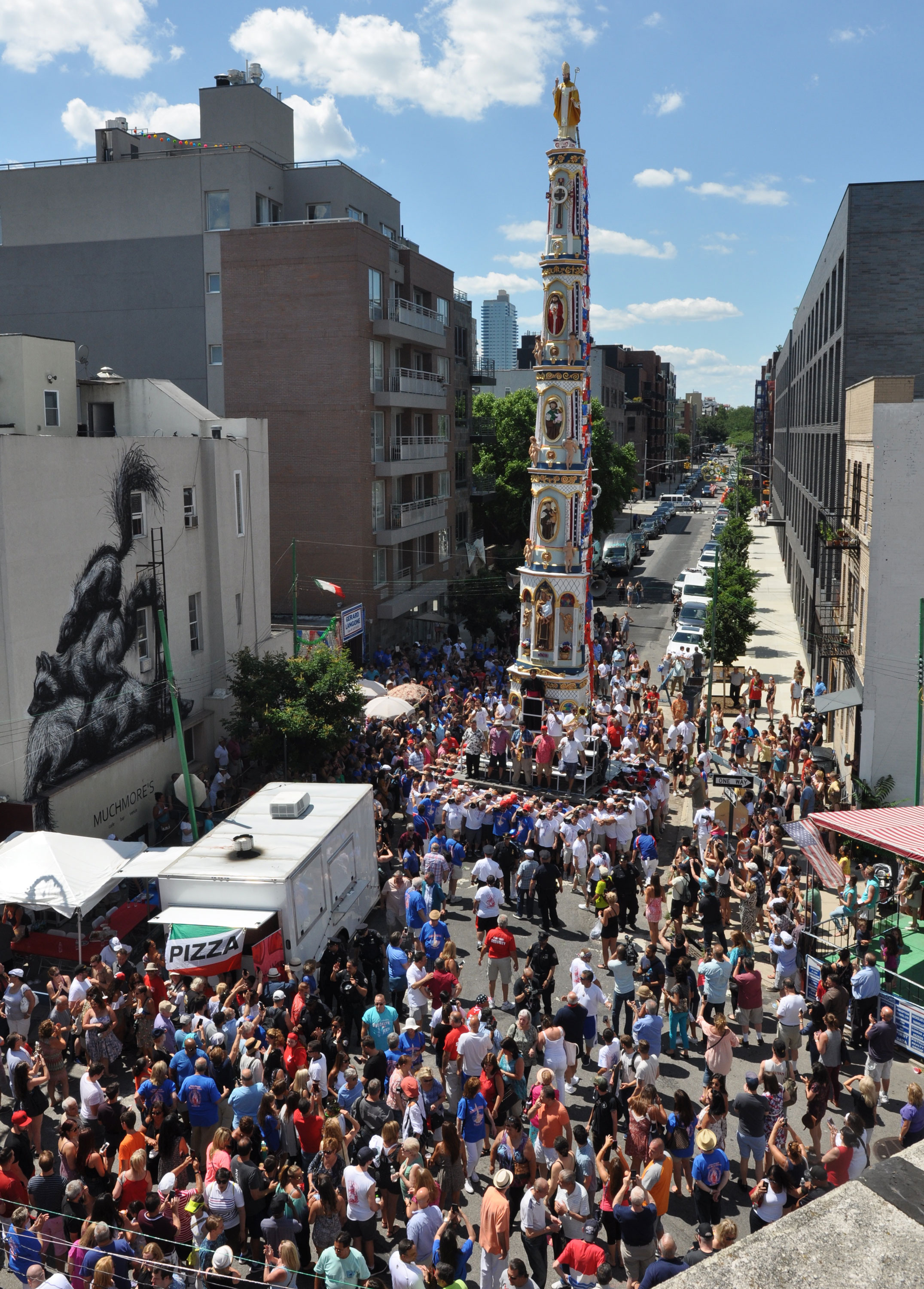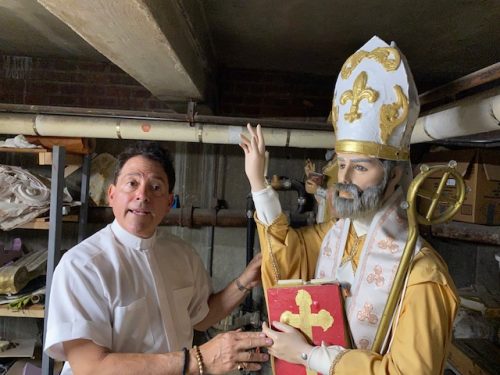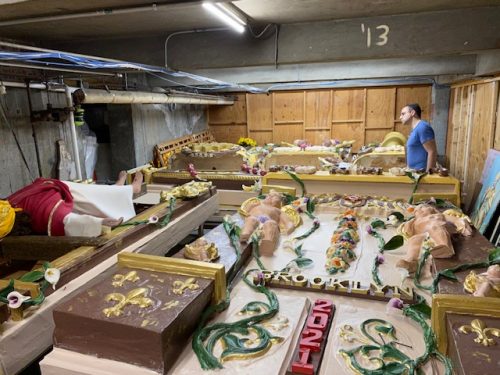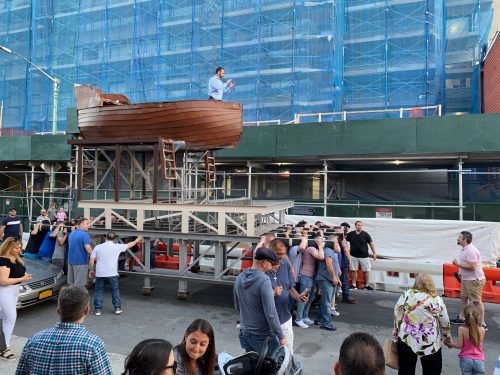
WILLIAMSBURG — Giglio Season is underway at the Shrine of Our Lady of Mount Carmel Parish, putting to rest any worries that this beloved Italian-American feast, now in its 134th year, might suffer a second pandemic-era setback.
Last year, parish leaders were forced to cancel their Feast of Our Lady of Mount Carmel & San Paolino Di Nola to comply with health and safety protocols established during the pandemic.
Now, as most restrictions have eased, preparations for the famed event — an annual Brooklyn tradition since at least 1903 — have moved forward.
This year’s edition is set for July 7-18 at the parish. Highlights include the ever-popular lifting and parading of the 70-foot, 4-ton tower called the Giglio.

The event’s “lieutenants,” “lifters,” “Capos,” and “Turks” are gearing up for a best-ever feast, hoping to heal the void left by last year’s cancellation. At the top of their “to-do” list is assembling the Giglio.
“Not having the feast (last year) was a big loss,” said Msgr. Jamie Gigantiello, parish pastor. “It wasn’t just about going to an event. It was the sentimental meaning of the feast — the connection that people have with the parish, with the old neighborhood, with their history, and their family members that passed on who were very much part of the feast.
“So it was a big void in many people’s lives.”
Msgr. Gigantiello also noted that the feast is the parish’s main fundraiser.
“The net revenue supports the parish for the whole year,” he explained. “People buy food from food stands that we rent. They also go on the rides, and we get a percentage of the proceeds. We also have sessions where people donate money. We have raffles, we have a cafe. So all those things add up, but last year that was all missing.”
Still, the event carries a religious tone that sets it apart from other events, Msgr. Gigantiello said.

The Feast of Our Lady of Mount Carmel includes a procession that steps off at 3 p.m. July 16. The parish’s statue of the Holy Mother holding the infant Jesus is reverently placed upon a float and paraded through the neighborhood.
“We have an opening Mass and closing Mass,” Msgr. Gigantiello said. “We have a novena every night at 7 o’clock. It’s much more religious. And, it’s in the neighborhood — you have all your local people coming to it. So, that’s what makes this different from a street festival.”
Giglio is the Italian word for lily, the flower that people of Nola, Italy, in the early 5th Century, brandished while witnessing the return from Moorish captivity of their beloved bishop, St. Paolino. In succeeding years, they built towering statues to commemorate his homecoming and paraded them through their streets.
Italian immigrants brought this tradition to the U.S. in 1887. The only other time the Giglio dance was not held was in 1945 when many young men from the neighborhood were away during World War II.

It takes 120 people to hoist the 4-ton structure. Brothers Dominic and Michael Franco, ages 14 and 13 respectively, got their first taste of the heavy lifting on the evening of June 23 when they participated in the annual “Taking out of the Boat” at the parish. The replica of the Moorish ship that returned St. Paolino to Nola is used in the Giglio dance.
The brothers are the sons of Philip Franco, a deacon for the parish. Both boys were visibly exhausted after helping to haul the boat. Still, they remained excited about their first opportunities to help tote the tower.
“Everyone is saying that it’s gonna be a lot easier because there’s going to be more guys,” Michael Franco said.
Msgr. Gigantiello can relate to their excitement. He helped carry a similar Giglio at his home parish of St. Rita’s in Long Island City. These days, as the pastor, he rides on the base of the Giglio along with a band that performs traditional music.
“When the Giglio first lifts up off the ground,” he said, “and when we walk around with the Blessed Mother on the float, and you see hundreds of people marching in front of you and behind you in devotion to Our Lady, it is very inspiring and uplifting.”
‘Giglio Hump’ a Symbol of Pride
WILLIAMSBURG — Joe DiDomenico tugged the top corner of his sleeveless t-shirt to reveal a massive shoulder splashed with an elaborate tattoo.
The burly Brooklyn man is a perennial “lifter” of the 4-ton Giglio tower during the annual summertime feast at Our Lady of Mount Carmel Parish.

After participating in the “Taking Out of the Boat” ceremony, DiDomenico urged reporter Bill Miller to come back for the actual feast, July 7-18.
“You’ll see a lot of these,” he said, motioning to his right shoulder.
“Oh, yeah,” Miller observed. “There’s a lot of tats out here tonight.”
“Nah, nah,” DiDomenico said. “Not the tat — the hump.”
“The hump?”
His left index finger tapped a knot the size of a tennis ball bulging at the top of his shoulder.
“That’s called a ‘Giglio Hump,’ ” DiDomenico said. “It’s from more than 35 years hauling these things. I had another one surgically removed.”
Lifters have done this work since the early 1900s, with the exceptions of last year and 1945, when parishioners were away at war.
The group on June 23 ranged in age from young teens to men in their 40s and 50s.
